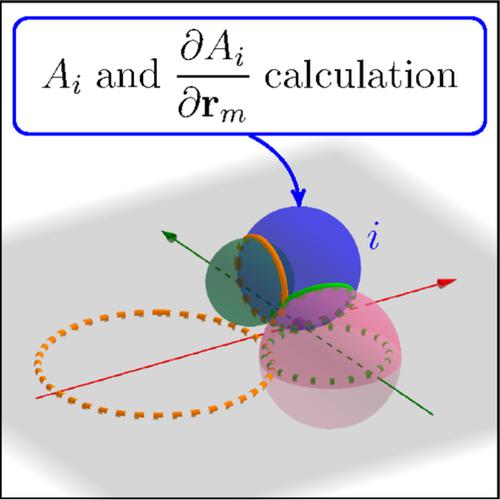当前位置:
X-MOL 学术
›
J. Comput. Chem.
›
论文详情
Our official English website, www.x-mol.net, welcomes your
feedback! (Note: you will need to create a separate account there.)
Analytical calculation of the solvent-accessible surface area and its nuclear gradients by stereographic projection: A general approach for molecules, polymers, nanotubes, helices, and surfaces
Journal of Computational Chemistry ( IF 3.4 ) Pub Date : 2020-03-25 , DOI: 10.1002/jcc.26191 Dario Vassetti 1 , Bartolomeo Civalleri 2 , Frédéric Labat 1
Journal of Computational Chemistry ( IF 3.4 ) Pub Date : 2020-03-25 , DOI: 10.1002/jcc.26191 Dario Vassetti 1 , Bartolomeo Civalleri 2 , Frédéric Labat 1
Affiliation

|
In this article, we explore an alternative to the analytical Gauss–Bonnet approach for computing the solvent‐accessible surface area (SASA) and its nuclear gradients. These two key quantities are required to evaluate the nonelectrostatic contribution to the solvation energy and its nuclear gradients in implicit solvation models. We extend a previously proposed analytical approach for finite systems based on the stereographic projection technique to infinite periodic systems such as polymers, nanotubes, helices, or surfaces and detail its implementation in the Crystal code. We provide the full derivation of the SASA nuclear gradients, and introduce an iterative perturbation scheme of the atomic coordinates to stabilize the gradients calculation for certain difficult symmetric systems. An excellent agreement of computed SASA with reference analytical values is found for finite systems, while the SASA size‐extensivity is verified for infinite periodic systems. In addition, correctness of the analytical gradients is confirmed by the excellent agreement obtained with numerical gradients and by the translational invariance achieved, both for finite and infinite periodic systems. Overall therefore, the stereographic projection approach appears as a general, simple, and efficient technique to compute the key quantities required for the calculation of the nonelectrostatic contribution to the solvation energy and its nuclear gradients in implicit solvation models applicable to both finite and infinite periodic systems.
中文翻译:

通过立体投影分析计算溶剂可及表面积及其核梯度:分子、聚合物、纳米管、螺旋和表面的通用方法
在本文中,我们探索了用于计算溶剂可及表面积 (SASA) 及其核梯度的分析 Gauss-Bonnet 方法的替代方法。这两个关键量是评估隐式溶剂化模型中溶剂化能及其核梯度的非静电贡献所必需的。我们将先前提出的基于立体投影技术的有限系统分析方法扩展到无限周期系统,如聚合物、纳米管、螺旋或表面,并在 Crystal 代码中详细说明其实现。我们提供了 SASA 核梯度的完整推导,并引入了原子坐标的迭代扰动方案,以稳定某些困难对称系统的梯度计算。对于有限系统,计算得到的 SASA 与参考分析值非常吻合,而对于无限周期系统,SASA 尺寸扩展性得到验证。此外,对于有限和无限周期系统,通过数值梯度获得的极好一致性以及所实现的平移不变性证实了解析梯度的正确性。因此,总体而言,立体投影方法似乎是一种通用、简单且有效的技术,用于计算在适用于有限和无限周期系统的隐式溶剂化模型中计算非静电对溶剂化能及其核梯度的贡献所需的关键量. 此外,对于有限和无限周期系统,通过数值梯度获得的极好一致性以及所实现的平移不变性证实了解析梯度的正确性。因此,总体而言,立体投影方法似乎是一种通用、简单且有效的技术,用于计算在适用于有限和无限周期系统的隐式溶剂化模型中计算非静电对溶剂化能及其核梯度的贡献所需的关键量. 此外,对于有限和无限周期系统,通过数值梯度获得的极好一致性以及所实现的平移不变性证实了解析梯度的正确性。因此,总体而言,立体投影方法似乎是一种通用、简单且有效的技术,用于计算在适用于有限和无限周期系统的隐式溶剂化模型中计算非静电对溶剂化能及其核梯度的贡献所需的关键量.
更新日期:2020-03-25
中文翻译:

通过立体投影分析计算溶剂可及表面积及其核梯度:分子、聚合物、纳米管、螺旋和表面的通用方法
在本文中,我们探索了用于计算溶剂可及表面积 (SASA) 及其核梯度的分析 Gauss-Bonnet 方法的替代方法。这两个关键量是评估隐式溶剂化模型中溶剂化能及其核梯度的非静电贡献所必需的。我们将先前提出的基于立体投影技术的有限系统分析方法扩展到无限周期系统,如聚合物、纳米管、螺旋或表面,并在 Crystal 代码中详细说明其实现。我们提供了 SASA 核梯度的完整推导,并引入了原子坐标的迭代扰动方案,以稳定某些困难对称系统的梯度计算。对于有限系统,计算得到的 SASA 与参考分析值非常吻合,而对于无限周期系统,SASA 尺寸扩展性得到验证。此外,对于有限和无限周期系统,通过数值梯度获得的极好一致性以及所实现的平移不变性证实了解析梯度的正确性。因此,总体而言,立体投影方法似乎是一种通用、简单且有效的技术,用于计算在适用于有限和无限周期系统的隐式溶剂化模型中计算非静电对溶剂化能及其核梯度的贡献所需的关键量. 此外,对于有限和无限周期系统,通过数值梯度获得的极好一致性以及所实现的平移不变性证实了解析梯度的正确性。因此,总体而言,立体投影方法似乎是一种通用、简单且有效的技术,用于计算在适用于有限和无限周期系统的隐式溶剂化模型中计算非静电对溶剂化能及其核梯度的贡献所需的关键量. 此外,对于有限和无限周期系统,通过数值梯度获得的极好一致性以及所实现的平移不变性证实了解析梯度的正确性。因此,总体而言,立体投影方法似乎是一种通用、简单且有效的技术,用于计算在适用于有限和无限周期系统的隐式溶剂化模型中计算非静电对溶剂化能及其核梯度的贡献所需的关键量.











































 京公网安备 11010802027423号
京公网安备 11010802027423号